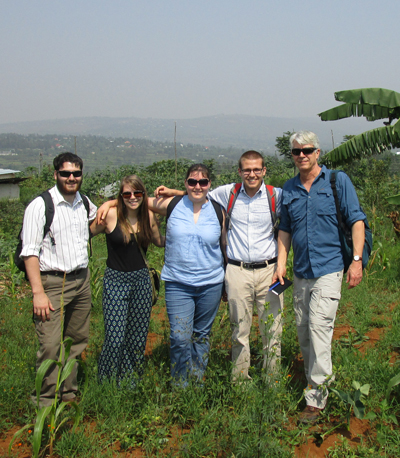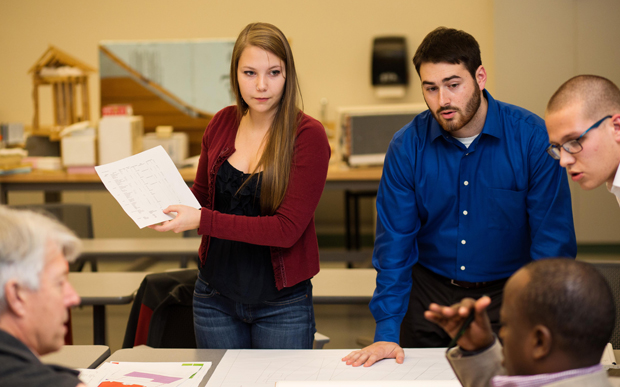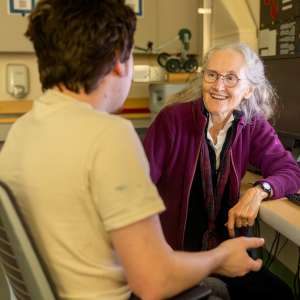Architecture Students Design Health Clinic for Rwanda

Due largely to the relationships Professor of Sociology and Anthropology Therese Seibert and a group of her sociology students formed through their participation in the yearly Peace Building Institute held in Rwanda, the Keene State community came together to help Dr. Aflodis Kagaba, executive director of Rwanda’s Health Development Initiative (HDI) realize the dream of creating a health care clinic that would provide equal opportunity for medical services for all Rwandans, including the LGBT community and other marginalized groups. Dr. Seibert obtained a grant to bring Dr. Kagaba and Betty Mutesi, project manager for International Alert, Rwanda/Burundi, to campus last fall to explain why there is a need for this healthcare facility, how the facility will address this need, and how we can help.
Obviously, one of the first—and maybe biggest—hurdles facing such a project is creating the building that will house it. Had Dr. Kagaba found himself at any other college in New England, it’s likely that he’d still be trying to solve that big piece of the puzzle. But when Associate Professor of Architecture Peter Temple learned of the need, he and a team of student architects, Michael Kelly, Darcy Stebbins, Adam Beaulieu, and Fiona Laurie, welcomed the challenge, and the chance to gain real-world design experience while providing a critical service to the underserved people of Rwanda. Prof. Temple has accepted many invitations to share his sustainable architectural design skills with organizations that can’t afford to hire professional architects and, through his Communicorps classes, present his students with opportunities to test the theories they’re learning in the classroom and design buildings for members of the local or international community who have the need, but not usually the means. One good example is the Vocational School another Communicorps class designed in Haiti.
The Communicorps team began the initial planning when Dr. Kagaba and Ms. Mutesi were on campus, using such tools as Google Earth to get a better idea of the building site. After Dr. Kagaba and Ms. Mutesi had returned to Rwanda, the team tried to continue the discussion and planning via Skype, but the poor connection and time difference made that difficult. So the team decided to travel to Rwanda for two weeks over winter break to check out the site and better understand the particular challenges of building in that country.

And the particular challenges they found will certainly push the envelope of their architecture training. For one, there’s no reliable supply of clean water in Rwanda. Even well-to-do neighborhoods sometimes run out. The same goes for electricity: the grid goes down sometimes. It’s difficult to run an effective hospital when you can’t depend on those basic utilities. Perhaps the biggest surprise came when the team learned that hospitals in Rwanda don’t have kitchens to prepare food for their patients. A patient’s family camps outside the hospital and prepares food for their relative over a wood or charcoal fire. Not a good situation if the patient has a communicable disease. Add to that the fact that the hospitals have no laundry facilities, so all the sheets, pillow cases, and hospital gowns get washed by hand.
Alternative Solutions
Fortunately, Prof. Temple is well versed in alternative ways to solve such problems. “We’re looking at solar hot water, which isn’t very commonly done there,” he explained. “We toured a couple of health centers that are similar to what our clients want, and they didn’t have a hot water supply. When they need it, they heat it in a tea kettle on a stove—usually a wood or charcoal fire. So solar hot water should be fairly easy to do there. Since the climate is very mild, you can use simple equipment, without freeze protection. It’s sunny almost every day, so if you just run the water over black metal, or through a black hose, you can get it pretty hot. We’re also hoping to bring in solar photovoltaics because electricity is incredibly expensive. And we’re looking at more efficient ways of cooking, perhaps using small stoves made from fired clay, instead of the usual open fires, where most of the energy is wasted.”
Begin pull-quote…This project is one that requires us to take a new perspective on design. …end pull-quote
In fact, it sounds like the clinic the Communicorps team designs may well be the nicest one in the country. “We want to show them new and better ways of doing things,” Prof. Temple said. “We met with the city engineer who said ‘When a university comes in to do a project like this, we hope to see some innovative approaches.’ Solar hot water systems are unusual there simply because no one has done it yet. So the Rwandans are hoping that we can demonstrate some things that haven’t been done before but that others will want to copy.”
“This project is one that requires us to take a new perspective on design,” said Communicorps team member Michael Kelly. “It is not like designing a similar facility here in the USA. The materials, building practices, design needs, and politics are all different. Remembering that and attempting to apply it is a challenge. Being able to apply our studio experience to a real-world problem is a great feeling and an important one.”
Avenues for Collaboration
This project has opened several avenues for collaboration and spreading alternative ways to meet needs. The University of Rwanda has a School of Architecture, which the Keene State contingent visited. Prof. Temple saw this as a way to get the Rwandan professors and students involved in designing the clinic. “It turns out that they have never before done actual projects; their students are just doing theoretical learning,” Prof. Temple discovered. “They haven’t had the time and resources to do what we do here with the Communicorps program. Rwanda has a high drop-out rate among secondary school students. Traditional sitting-in-the-classroom, book learning is not keeping students involved, so the faculty are very interested in the model of problem-based service learning. They would like to do more projects that help solve the world’s problems, like we do here. The Dean of the School of Architecture was very supportive.”
One of the faculty members, Alice Tasca, is an Italian architect working in a firm in Kigali called Active Social Architecture that specializes in designing schools and health centers. “What a great resource,” Prof. Temple noted. “She showed us three health centers they’d done recently, and we discussed several issues, such as the best ways to deal with HIV patients and for getting good natural ventilation without using a lot of electricity and fans.”
So how did the team get the money to travel all the way to Rwanda? Gordon Leversee, the dean of Sciences and Social Sciences, supported the project so the travelers could book their flights and make the necessary arrangements. “He fronted the money in the hope that we would get enough through grants to pay him back, and we’ve about done that,” Prof. Temple explained. “I applied for a Faculty Development Grant, and the students applied for Undergrad Research Grants and got some funding from Kemal Atkins, vice president for Student Affairs and Enrollment Management. Dottie Morris gave us some funding from the Office of Diversity and Multiculturalism, and, of course, Therese Seibert, because she was so involved with Rwanda, helped a lot.”
There’s still a long way to go before the first patient is admitted to the new clinic, but already the work is bearing fruit, creating important opportunities now and more that should extend far into the future. “The design work will be great to include in my portfolio, but the coordination and management of the project, in terms of carrying out the design and necessary research will be able to benefit me greatly as well,” Michael Kelly said. “Traveling to Rwanda was an amazing experience. It is a very different from any place I’ve ever been; this has been an experience I will keep with me for my entire life.”
— Mark Reynolds





